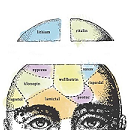A new meta-analysis published in Psychological Medicine finds that Eye Movement Desensitization and Reprocessing (EMDR) therapy is effective in treating post-traumatic stress disorder (PTSD), but offers no significant advantage over other psychological treatments. The study also highlights the role of social factors, specifically employment status and gender, in shaping how individuals respond to therapy.
Despite EMDR being listed among the first-line treatments for PTSD, this individual participant data meta-analysis found no significant differences between EMDR and other therapies in reducing symptom severity, achieving treatment response, attaining remission, or lowering dropout rates. However, the researchers did find that unemployed participants receiving EMDR had higher PTSD symptom severity at post-test, and males were more likely to drop out of treatment.
The review, led by Simonne Lesley Wright of Stellenbosch University in South Africa, pooled individual-level data from eight randomized controlled trials (RCTs), including 346 adult participants with PTSD. The authors compared EMDR to a range of other evidence-based psychological treatments, such as trauma-focused cognitive behavioral therapy (CBT-TF), relaxation therapy, emotional freedom technique, and REM-desensitization.
“To the best of our knowledge, this is the first IPDMA to explore moderators of EMDR for adults with PTSD using individual participant-level data,” the authors write. “One of the strengths of the present study was the statistical power to detect statistically significant moderators compared with study-level MA and published RCTs aimed at investigating the efficacy of EMDR for adults with PTSD. This IPDMA made it possible to investigate available participant-level moderators, such as employment status and gender.”
The study challenges assumptions about the superiority of any single trauma therapy by showing that diverse psychological treatments yield similar outcomes for PTSD. It also highlights how structural factors like employment status and gender shape treatment effectiveness, underscoring the need to address social context rather than focusing solely on technique.
















Try William M Epstein’s work on the evidence base for therapy – he takes apart the best of the studies and looks in detail at them on methodological grounds for a range of so called evidence based therapies EMDR included – he shoes they are of terrible quality – try this AI summarised from Epstein re EMDR:
1. Questionable Scientific Foundations
Epstein argues that EMDR’s mechanisms—such as the bilateral stimulation through eye movements—lack a plausible scientific rationale. He sees the theoretical foundation of EMDR as vague or unsubstantiated, especially the claim that eye movements can facilitate the processing of traumatic memories.
2. Flawed Research Methodologies
He critiques the research supporting EMDR as methodologically weak. Specifically, he points to:
Small sample sizes.
Poor controls in experimental design.
Selective reporting of positive outcomes.
Lack of long-term follow-up in many studies.
Epstein contends that the apparent effectiveness of EMDR in trials often reflects these methodological issues rather than true therapeutic efficacy.
3. The Placebo Problem
Epstein suggests that EMDR may function primarily as a placebo, with any effectiveness arising from nonspecific therapeutic factors—like attention, suggestion, and structured support—rather than from the specific techniques (e.g., eye movements) claimed to be central to EMDR.
4. Ideological and Institutional Interests
He argues that the popularity and institutional acceptance of EMDR (including endorsements by organizations like the APA and WHO) may reflect political and ideological pressures more than scientific validity. Epstein frequently emphasizes that practices often become “evidence-based” through institutional mechanisms rather than through genuinely rigorous testing.
5. Critique of the “Evidence-Based” Label
In line with his wider critique of evidence-based practice, Epstein sees the validation of EMDR as an example of how the label “evidence-based” can be misleading. He argues that what counts as “evidence” is often defined in ways that support prevailing professional, political, or commercial interests, rather than representing a true scientific consensus.
In Summary:
Epstein views the evidence base for EMDR as methodologically suspect, theoretically weak, and ideologically driven. He uses EMDR as a case study in how unproven or poorly understood treatments can gain legitimacy through flawed science and institutional endorsement, rather than through robust empirical validation.
Let me know if you’d like quotes or references from Epstein’s works to support this summary.
Report comment
I have always thought the eye movement part to be of no importance. It’s basically a regressive therapy, which has always worked for some folks if done well, but doesn’t work for everyone.
That’s the other silly thing about “Evidence Based Therapy” – we are assuming that a percentage of people saying they benefit from a certain approach makes it most effective for everyone, when it may be only effective for that percentage and better approaches may be better for others. Why do we think one “treatment” is going to “work” for everyone with a certain emotional state? Why wouldn’t it depend on the person and their needs? It’s the “medical model” being forced in where it doesn’t belong.
Report comment
Why do we think one “treatment” is going to “work” for everyone with a certain emotional state?
Because they have the same type of damage….and according to this study it can be reversed….and it’s doable. They used SAMe to increase methylation and Vitamin A because it works on TH17. (but SAMe can’t be used by those with Bipolar because it can cause mania).
https://neurosciencenews.com/nutritional-supplements-ptsd-19078/?fbclid=IwY2xjawKSKc5leHRuA2FlbQIxMQBicmlkETFSMG9nelhBM0M4aTFaZEYyAR7KlgPXawaUKw6k1XcJcxaZbMtCBb0FGlUZnpYiRrYvA5fCtCN1Xz2rh9PFSw_aem_iuvddEiUo9bkdM727e0TNw
It worked….in mice
Report comment
But they DON’T have the same type of damage. SOME have the same type of damage. Others do not. Until we can tell who has, say TH17 problems of a certain type, we are still shooting in the dark. Once we can make such distinction, we can determine who has TH17 damage and treat them for TH17 damage. But we are no longer treating “depression,” we’re treating TH17 damage. And those who DON’T have TH17 damage will need something else. Can you see this difference?
Report comment
Veterans says it helps, but it’s done as part of intensive therapy. They have to write a detailed letter about the event that caused the trauma, like how you were in this tiny plane with no doors kicking flares out the door to light up the area below and the enemy was shooting at you the entire time and you thought you were about to die and when you finally got off the plane and you thought it was over, you were told to load up more flares because you had to do it again.
I don’t think your eyes can move back and forth fast enough to forget that.
Report comment
I think it can help because they are reviewing the traumatic events and bleeding off the intense emotion that is associated with it. That’s basic psychodynamic therapy. The only good thing I think EMDR adds is looking at earlier incidents if the incident in question doesn’t resolve or at least reduce in intensity after being reviewed. All that is logical. The eye movement part is not.
Report comment
When you dig down only 8 studies have data available. Half the subjects have tertiary education. None of the studies were conducted in routine practice. I spent an hour trying to answer the simple question of what proportion of those treated felt that they were back to their old selves after treatment. This common sense benchmark was not used at all. The studies do mention loss of diagnostic status determined by interview but again I searched in vain for the proportions involved. Gender is mentioned as a predictor but it only predicted that males were more likely to drop out of EMDR. Those who were unemployed were more likely to score worse at the end of treatment, no surprise there. Governments work to reduce unemployment, but have failed to eradicate it and it is not likely to be attained any time soon. There is a need to go back to basics in evaluating studies. Obscuring and marketing seem to figure prominently.
Mike
Report comment
I have an unusual perspective on this question. All studies of therapeutic models suffer from the problem that even the same therapist will alter treatment from one subject to the next. This makes all results suspect.
I developed an EMDR self-help program, that is identical from one subject to the next, regardless of what trauma they had suffered. The only difference in application was that some clients would follow directions and others did not. Most would listen to the program with headphones or earbuds that created an REM state in the brain by alternating classical music and guided imagery from one ear to the other. A significant number of clients ignored the directions and listened to it on a stereo, with no bi-lateral stimulation. The difference in therapeutic response was Stunning. Over 80% who listened to it with Bi-lateral stimulation had a strong positive effect, close to the word, cure. Those who listened to the program ignoring directions, had a less than 10% small positive effect. Some of what this means is that the brain heals itself when doing therapeutic work while in an REM state. Someday this will be unquestionably proven and accepted.
Report comment